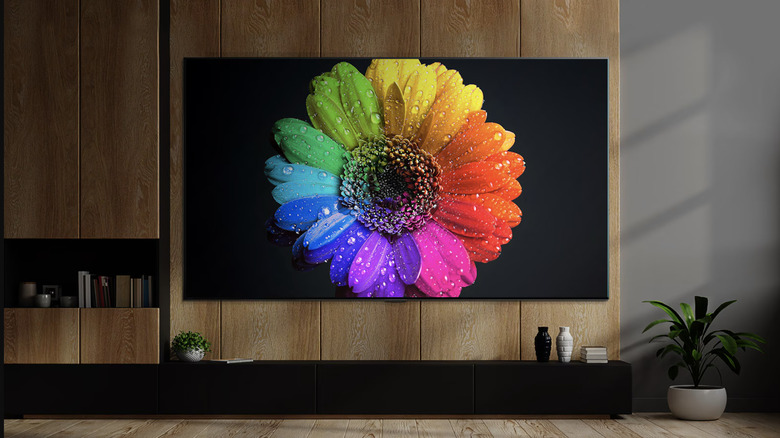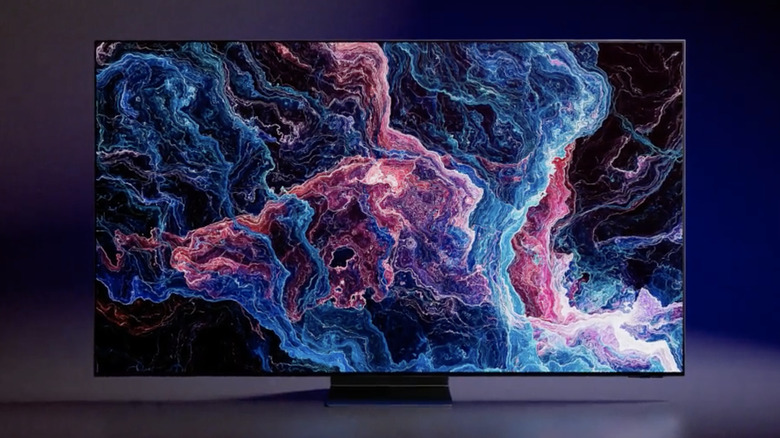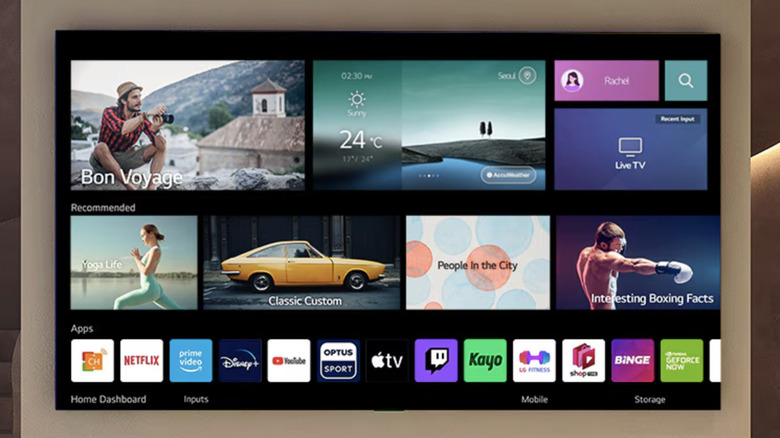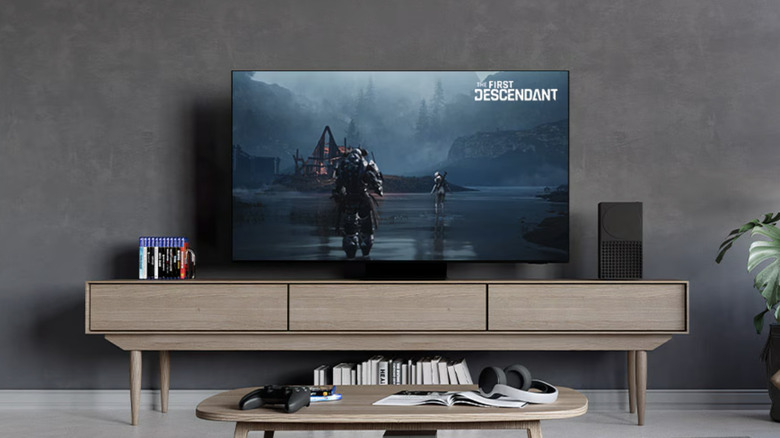QNED Vs. OLED: What's The Difference And Which Is Better For TV Displays?
We may receive a commission on purchases made from links.
Shopping for a new TV isn't easy these days as they come with so many acronyms and abbreviations that even the most tech-savvy among us might have trouble deciphering them all. Before making a purchase, you might need to know about things like quantum dots, the difference between active versus passive 3D TVs, or whether an 8K TV is worth the price tag, just to make an educated decision.
Given the amount of screen-related TV tech terminology being bandied about, it's no wonder many people throw their hands up in frustration and simply choose the first TV that catches their eye. And nobody would blame them. After all, there's a lot to sift through when buying a TV.
If you're in the market for a new TV, you've probably come across QNED and OLED TVs. QNED stands for quantum nano-emitting diode and is the name LG has given to its TVs that use a combination of quantum dots, NanoCell technology, and mini-LED backlighting.
OLED is short for organic light-emitting diode and refers to TVs that use organic compounds to produce light for each pixel individually, in contrast to traditional LED and LCD TVs that use a backlight to illuminate the screen. As you can see, there are a lot of different TV technologies vying for your attention, and digging a bit deeper can help you figure out which is best for you.
What is QNED?
LG has a pretty extensive lineup of QNED TVs, so if you spend any time shopping for a new TV, you're likely to encounter a few of them. The 2024 QNED lineup even includes a 98-inch behemoth and an increased focus on AI. Given how common LG TVs are, understanding their QNED technology can help you decide if one of them is right for you.
When you view a QNED TV, you're looking at a screen with thousands of mini-LEDs — as many as 30,000 — to deliver better brightness and color accuracy than traditional LCD TVs. These LEDs work together with around 2,500 dimming zones to reduce the bloom or halo effect you sometimes see around the darkest parts of the screen on LED and LCD TVs.
QNED TVs use quantum dots, which are semiconducting nanocrystals that can emit a broad spectrum of colors. The biggest advantages of QNED TVs are their improved contrast ratios and brighter displays, which makes them especially suitable for HDR and bright rooms.
What is OLED?
For many people shopping for TVs, the question of LED versus OLED comes up often. We won't cover that here, but the differences are worth considering before you buy a new TV. OLEDs are among the most common TVs and, by most standards, the best on the market.
What makes these TVs stand out is the ability of each pixel on an OLED display to emit its own light. Since each pixel can be controlled individually, these TVs can produce true blacks and a high contrast ratio, as well as vivid colors and sharp images. It's this pixel-level control that makes it possible for OLEDs to achieve superior color accuracy and wide color gamut, which can display a broader range of colors with greater precision.
OLEDs also have a greater viewing angle, where consistent picture quality is maintained even when viewing the TV from extreme angles. If you have a home theater setup that doesn't allow everyone to sit directly in front of the screen, being able to view an undistorted image regardless of seating position is a big advantage. They also have very fast response times, often around 0.1ms, which makes them ideal for gaming or watching sports.
What are the differences between QNED and OLED?
While they both use advanced technologies to improve the TV viewing experience, there are quite a few differences between QNED and OLED TVs. OLEDs use self-emissive technology that results in displays with greater color accuracy, deep blacks, and high contrast ratios.
In contrast, QNEDs use of mini-LED backlighting with quantum dots and NanoCell technology produces bright displays with better color accuracy than traditional LCD technology. However, it can't match OLEDs ability to produce real black because QNEDs are susceptible to some light bleed.
Compared to QNEDs, OLED screens generally have lower peak brightness, which makes them a better choice for controlled lighting situations like you'd find in a home theater. In rooms with a lot of ambient light, QNEDs have an advantage because their higher brightness levels enhance visibility and reduce glare. While OLEDs maintain consistent picture quality and color regardless of the angle, QNEDs struggle when viewed from extreme angles.
When it comes to durability, a major concern for OLEDs is the potential for burn-in, where static images leave permanent marks on the screen. However, this isn't as much of a concern with modern OLEDs, with many coming equipped with a correction system that resets the pixels to their default state from time to time. Screen burn-in is much less of a risk for QNED TVs because they use backlighting instead of self-emissive pixels.
Is QNED or OLED better for TV displays?
The choice between a QNED or OLED TV is a subjective one, and a lot will depend on personal preferences and viewing environment. Hands down, OLEDs have superior picture quality, producing stunning visuals, especially in dark scenes. This makes them an ideal choice for watching movies in dimly lit rooms. However, since they generally have lower peak brightness than QNEDs, if you'll mostly be watching TV in a bright room or where you can't control the amount of light, a QNED TV might serve you better.
Both QNEDs and OLEDs have respectable lifespans, with OLEDs expected to last between five and ten years, or 30,000 and 100,000 hours, and QNEDs lasting anywhere from seven to eight years, or 50,000 to 60,000 hours. OLEDs excel at gaming due to their low input lag, high refresh rates, and near-instantaneous response times. That's not to say that QNEDs aren't good for gaming; they are, but their response times can't compete with OLEDs.
QNED TVs are typically more affordable than OLEDs and offer a good balance of performance and cost. The self-emitting pixel technology OLEDs use contributes to their generally higher cost. LG is the only manufacturer of QNED TVs, while premium and mid-range OLED TVs are available from a range of manufacturers.




